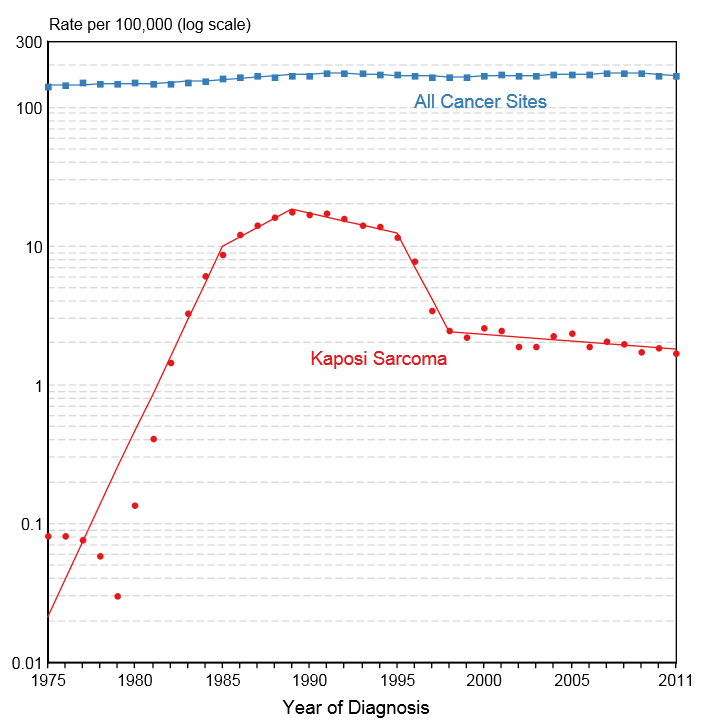Kaposi's sarcoma epidemiology and demographics: Difference between revisions
Jump to navigation
Jump to search
Farima Kahe (talk | contribs) No edit summary |
Farima Kahe (talk | contribs) (→Gender) |
||
| Line 24: | Line 24: | ||
===Gender=== | ===Gender=== | ||
*AIDS-related Kaposi sarcoma usually occurs in young to middle aged patients aged 20-54 years.<ref name="pmid25139791">{{cite journal |vauthors=Luu HN, Amirian ES, Chiao EY, Scheurer ME |title=Age patterns of Kaposi's sarcoma incidence in a cohort of HIV-infected men |journal=Cancer Med |volume=3 |issue=6 |pages=1635–43 |date=December 2014 |pmid=25139791 |pmc=4298390 |doi=10.1002/cam4.312 |url=}}</ref> | |||
* | *Classic Kaposi sarcoma generally seen in patients aged 50-70 years.<ref name="pmid26035321">{{cite journal |vauthors=Labo N, Miley W, Benson CA, Campbell TB, Whitby D |title=Epidemiology of Kaposi's sarcoma-associated herpesvirus in HIV-1-infected US persons in the era of combination antiretroviral therapy |journal=AIDS |volume=29 |issue=10 |pages=1217–25 |date=June 2015 |pmid=26035321 |doi=10.1097/QAD.0000000000000682 |url=}}</ref> | ||
* | *African Kaposi sarcoma occurs in younger age around 35-40 years old. | ||
===Race=== | ===Race=== | ||
Revision as of 15:19, 17 September 2018
|
Kaposi's sarcoma Microchapters |
|
Diagnosis |
|---|
|
Treatment |
|
Case Studies |
|
Kaposi's sarcoma epidemiology and demographics On the Web |
|
American Roentgen Ray Society Images of Kaposi's sarcoma epidemiology and demographics |
|
Risk calculators and risk factors for Kaposi's sarcoma epidemiology and demographics |
Editor-In-Chief: C. Michael Gibson, M.S., M.D. [1]; Associate Editor(s)-in-Chief: Rim Halaby, M.D. [2]
Overview
In the United States, the age-adjusted prevalence of Kaposi sarcoma is 8.1 per 100,000. The age-adjusted incidence of Kaposi sarcoma was 0.64 per 100,000 persons in the United States in 2011.
Epidemiology and Demographics
Prevalence
- In the United States, the age-adjusted prevalence of Kaposi sarcoma is 8.1 per 100,000 in 2011.[1]
Incidence
- In 2011, the age-adjusted incidence of Kaposi sarcoma was 0.64 per 100,000 persons in the United States.[1]
- Shown below is an image depicting the incidence of Kaposi sarcoma versus all types of cancers in the United States from 1975 to 2011.
Age
- While the overall age-adjusted incidence of Kaposi sarcoma in the United States between 2007 and 2011 is 0.5 per 100,000, the age-adjusted incidence of Kaposi sarcoma by age category is:[1]
- Under 65 years: 0.5 per 100,000
- 65 and over: 1 per 100,000
Gender
- AIDS-related Kaposi sarcoma usually occurs in young to middle aged patients aged 20-54 years.[2]
- Classic Kaposi sarcoma generally seen in patients aged 50-70 years.[3]
- African Kaposi sarcoma occurs in younger age around 35-40 years old.
Race
- Shown below is a table depicting the age-adjusted prevalence of Kaposi sarcoma by race in 2011 in the United States.[1]
| All Races | White | Black | Asian/Pacific Islander | Hispanic | |
| Age-adjusted prevalence | 8.1 per 100,000 | 8 per 100,000 | 12.4 per 100,000 | 2 per 100,000 | 11.1 per 100,000 |
References
- ↑ 1.0 1.1 1.2 1.3 Howlader N, Noone AM, Krapcho M, Garshell J, Miller D, Altekruse SF, Kosary CL, Yu M, Ruhl J, Tatalovich Z,Mariotto A, Lewis DR, Chen HS, Feuer EJ, Cronin KA (eds). SEER Cancer Statistics Review, 1975-2011, National Cancer Institute. Bethesda, MD, http://seer.cancer.gov/csr/1975_2011/, based on November 2013 SEER data submission, posted to the SEER web site, April 2014.
- ↑ Luu HN, Amirian ES, Chiao EY, Scheurer ME (December 2014). "Age patterns of Kaposi's sarcoma incidence in a cohort of HIV-infected men". Cancer Med. 3 (6): 1635–43. doi:10.1002/cam4.312. PMC 4298390. PMID 25139791.
- ↑ Labo N, Miley W, Benson CA, Campbell TB, Whitby D (June 2015). "Epidemiology of Kaposi's sarcoma-associated herpesvirus in HIV-1-infected US persons in the era of combination antiretroviral therapy". AIDS. 29 (10): 1217–25. doi:10.1097/QAD.0000000000000682. PMID 26035321.
